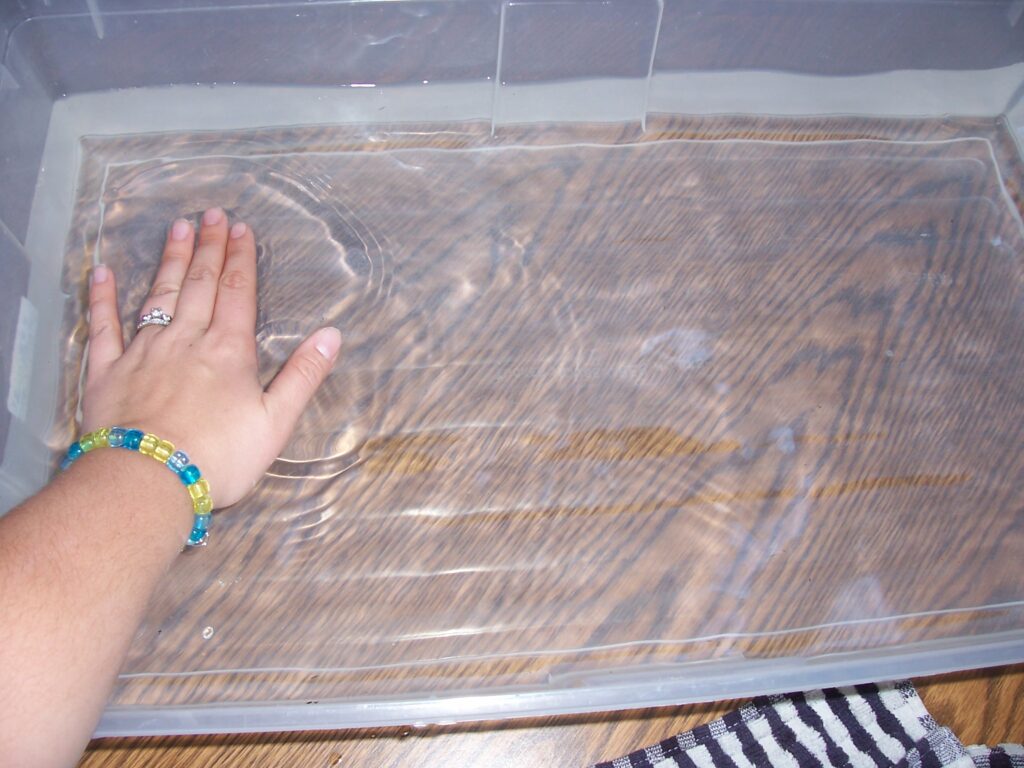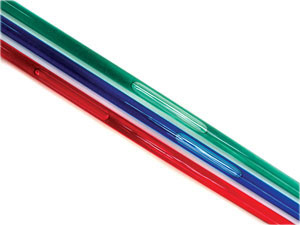June 9, 2012
 by: Michelle Bertke
by: Michelle Bertke
Sound can be a difficult concept to portray because the sound waves cannot be seen or touched. Luckily, there are several at home experiments that demonstrate the properties of sound waves.
Water tank to show ‘Sound Waves’
You can use a fish tank half filled with water to give a visual demonstration  of ‘sound waves’. Water is a perfect medium to show the propagation of waves. This demonstrates how sound waves travel though the air. There are two ways to display this activity. One way is to simply press your hands onto the top of the water and allow the waves to be made by the pressure of your hand. This allows students to see how waves travel though a medium. You can also use this to point out the aspects of a wave such as frequency and amplitude. Another way to show waves is to place a speaker next to the tank and allow the sound to produce the waves. This can show that sound is a form of pressure just like your hand. Read the rest of this entry »
of ‘sound waves’. Water is a perfect medium to show the propagation of waves. This demonstrates how sound waves travel though the air. There are two ways to display this activity. One way is to simply press your hands onto the top of the water and allow the waves to be made by the pressure of your hand. This allows students to see how waves travel though a medium. You can also use this to point out the aspects of a wave such as frequency and amplitude. Another way to show waves is to place a speaker next to the tank and allow the sound to produce the waves. This can show that sound is a form of pressure just like your hand. Read the rest of this entry »
 Leave a Comment » |
Leave a Comment » |  Elementary level, energy, experiments | Tagged: frequency, PBL, phenomenon based learning, phenomenon-based science, pitch, properties of sound, science, sound experiments, sound waves, tone, vibration |
Elementary level, energy, experiments | Tagged: frequency, PBL, phenomenon based learning, phenomenon-based science, pitch, properties of sound, science, sound experiments, sound waves, tone, vibration |  Permalink
Permalink
 Posted by Tami O'Connor
Posted by Tami O'Connor
April 28, 2012
 by: Cindy House
by: Cindy House
Bubbles in tubes offer many advantages over spheres on ramps for velocity and acceleration experiments:
- The bubble stays in the tube! There are no escaped marbles to chase down.
- The bubble moves more slowly than a marble, permitting more accurate determination of elapsed time.
- Results are highly reproducible.
- Many data points can be collected in a short period of time.

A Speed of the Bubble Apparatus to hold and protect the tube is easy to construct from scrap and/or inexpensive materials. It enables even very young students to obtain highly reproducible data quickly. It also protects the tubes from being damaged if dropped or bumped. Plans and suggested materials are included in this blog. The following experiment is one I use with the elementary students in our after school science club. Read the rest of this entry »
 5 Comments |
5 Comments |  Elementary level, experiments, High School level, Middle School level, Physics | Tagged: acceleration, collecting data, measurement, PBL, phenomenon based learning, phenomenon-based science, science, science fair project, speed, variables, velocity |
Elementary level, experiments, High School level, Middle School level, Physics | Tagged: acceleration, collecting data, measurement, PBL, phenomenon based learning, phenomenon-based science, science, science fair project, speed, variables, velocity |  Permalink
Permalink
 Posted by Tami O'Connor
Posted by Tami O'Connor
January 11, 2012
 by: Tami O’Connor – Taken From Litetronics
by: Tami O’Connor – Taken From Litetronics
The radiometer is a light bulb-shaped device containing an object that looks like a weather vane (wings arranged in a circle like spokes of a wheel). Developed to measure the intensity of radiant energy, or heat, the radiometer will:
- Help you understand the principles of energy conversion.
- Show how heat and mechanical energy are products of energy conversion.
Read the rest of this entry »
 20 Comments |
20 Comments |  Elementary level, energy, experiments, Middle School level, Physics | Tagged: energy conversion, homeschool, infrared energy, kinetic energy, light energy, parent friendly, PBL, phenomenon based learning, phenomenon-based science, potential energy, radiometer, science, science fair project |
Elementary level, energy, experiments, Middle School level, Physics | Tagged: energy conversion, homeschool, infrared energy, kinetic energy, light energy, parent friendly, PBL, phenomenon based learning, phenomenon-based science, potential energy, radiometer, science, science fair project |  Permalink
Permalink
 Posted by Tami O'Connor
Posted by Tami O'Connor
December 2, 2011
 by: Martin Sagendorf
by: Martin Sagendorf
One Pendulum…
Is interesting, but…
Two Pendulums…
Are much more interesting.
But only if they are coupled pendulums.
Read the rest of this entry »
 4 Comments |
4 Comments |  College level, energy, experiments, High School level, Middle School level, Physics | Tagged: coupled pendulums, energy, harmonic motion, momentum, pendulums, Physics, resonance |
College level, energy, experiments, High School level, Middle School level, Physics | Tagged: coupled pendulums, energy, harmonic motion, momentum, pendulums, Physics, resonance |  Permalink
Permalink
 Posted by Tami O'Connor
Posted by Tami O'Connor
November 26, 2011
 by: Martin Sagendorf
by: Martin Sagendorf
Most everyone knows that an equilateral prism will refract white light into its constituent colors: a spectrum ranging from red to violet. But, if one uses two prisms, there’s much more to be discovered.
All that’s required:
Read the rest of this entry »
 8 Comments |
8 Comments |  High School level, Middle School level, Physics | Tagged: light, light spectrum, PBL, phenomenon based learning, phenomenon-based science, prisms, refraction, science, Sir Isaac Newton |
High School level, Middle School level, Physics | Tagged: light, light spectrum, PBL, phenomenon based learning, phenomenon-based science, prisms, refraction, science, Sir Isaac Newton |  Permalink
Permalink
 Posted by Tami O'Connor
Posted by Tami O'Connor
 by: Michelle Bertke
by: Michelle Bertke of ‘sound waves’. Water is a perfect medium to show the propagation of waves. This demonstrates how sound waves travel though the air. There are two ways to display this activity. One way is to simply press your hands onto the top of the water and allow the waves to be made by the pressure of your hand. This allows students to see how waves travel though a medium. You can also use this to point out the aspects of a wave such as frequency and amplitude. Another way to show waves is to place a speaker next to the tank and allow the sound to produce the waves. This can show that sound is a form of pressure just like your hand. Read the rest of this entry »
of ‘sound waves’. Water is a perfect medium to show the propagation of waves. This demonstrates how sound waves travel though the air. There are two ways to display this activity. One way is to simply press your hands onto the top of the water and allow the waves to be made by the pressure of your hand. This allows students to see how waves travel though a medium. You can also use this to point out the aspects of a wave such as frequency and amplitude. Another way to show waves is to place a speaker next to the tank and allow the sound to produce the waves. This can show that sound is a form of pressure just like your hand. Read the rest of this entry »


 Posted by Tami O'Connor
Posted by Tami O'Connor  by: Cindy House
by: Cindy House
 by: Tami O’Connor – Taken From Litetronics
by: Tami O’Connor – Taken From Litetronics by: Martin Sagendorf
by: Martin Sagendorf